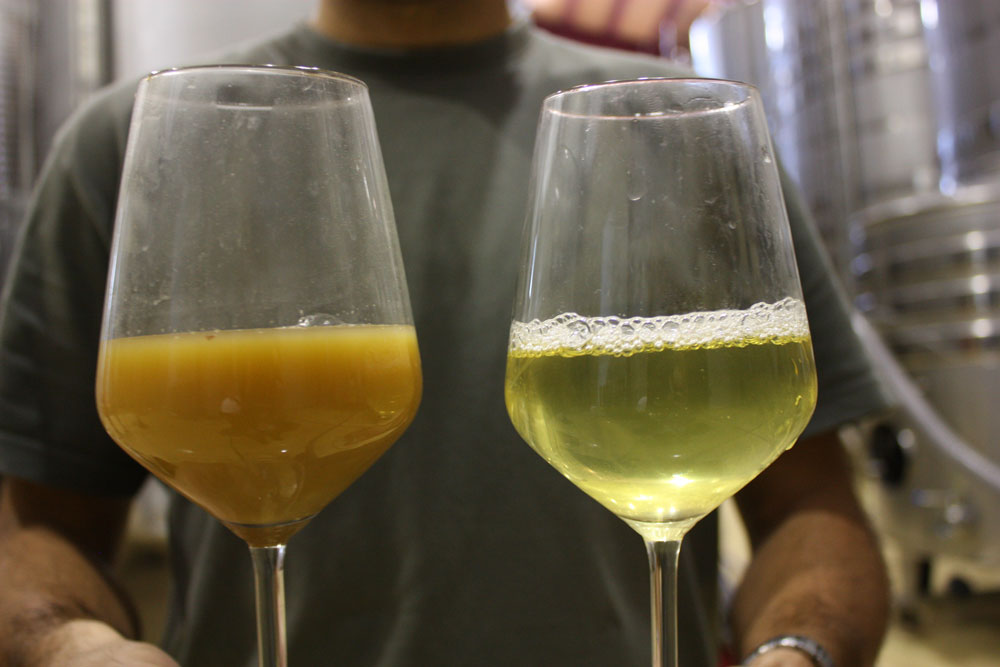 In principle, the wine clarifies itself, unless bacteria get in. There are also ways to give the wine complete clarity:
In principle, the wine clarifies itself, unless bacteria get in. There are also ways to give the wine complete clarity:
1. Regular pouring.
2. Light sulfurization.
3. Ensuring adequate levels of tannin.
Regular pouring
It is the pouring of importance that accelerates the clarification of the wine, but you should not be surprised, when at the bottom of the gander we notice sediment after 2-3 days after pouring the wine.
Light sulfurization
I have already advised, to add potassium metabisulphite to the wine after the first pouring. This minimizes the risk of wine oxidation during pulling, as well as helps to clarify the drink.
Tannin content
Too little of this substance is the cause of most of the trouble when making wine. Adequate tannin content improves fermentation quality and purifies wine.
Artificial clarification
If, despite taking into account the three above factors, the wine is cloudy, and this is not due to the precipitation of pectins or starch, we can try to clarify them in a different way. However, we only do this as a last resort., because naturally clarified wine is the best. Wine sets are available on the market, which contain various clarifying agents. They are usually bought by the most impatient manufacturers, wanting to shorten the clarification process as much as possible. Unfortunately, loses the quality of the drink.
Here are the most popular clarifying agents:
• gelatin from fish bladders (rarely found in Poland) – 28 g of this substance is enough for purification 45 litres of wine. Crush gelatin and dissolve in a cup of water with a pinch of tartaric acid. After a while we get jelly, which we add to the dish with a small amount of liquor and mix thoroughly. Pour the solution into the gander (gelatin poured directly into the gander is very difficult to dissolve);
• food gelatin – the main ingredient of food gelatin is gluten. We dissolve it in hot water (according to the instructions on the packaging) and add to the wine;
• albumin – egg white – one is enough for clarification 45 litres of wine. We break them with a little drink and add to the rest in the gąsiorze;
• milk – the casein contained in it also accelerates clarification, and additionally reduces the intensity of wine color. Let's prepare three small bottles and pour into each after 100 cm3 wine. To the first we add 1/2 cm3 of milk, to the second – 1 cm3, to the third – 1 and 1/2 cm3. Shake all the bottles tightly and set them aside 36 hours. After this time, we choose a bottle, whose content suits us best in terms of coloration. A correspondingly larger amount of milk should be added to the gander.
Because choosing the proportion of clarifying agents to small amounts of wine poses many difficulties, none of the above methods are very popular. Much simpler to use are the latest means, which we use according to the recipe on the packaging.
Do not increase the recommended proportions, because it may prevent the wine from clarifying.
Only for bentonite (a type of clay found in America) there is no risk of overdose. One flat teaspoon of dissolved substance in a cup of wine is enough for purification 4,5 Litre (you have to remember, to mix it very thoroughly, before we blow the solution into the gander). This agent greatly increases its volume, but it works quickly and effectively.
FILTERING
When all the ways fail, we can filter the wine, but let's treat it as a last resort. Filtering deprives wine not only of sediment, but also the desired substances. Many experienced winemakers say, that filtered wine never regains its original flavor, and sometimes even takes on the aftertaste of a filtering agent.
New filtering methods have recently been used. Until now, funnels and paper filters have been used. The wine was exposed to oxidation with this filtering method, because it has been in contact with air for a long time. Modern filtering agents make it possible to reduce contact with air to a minimum. Nevertheless, after using them, it is recommended to set the wine aside, that it could happen.